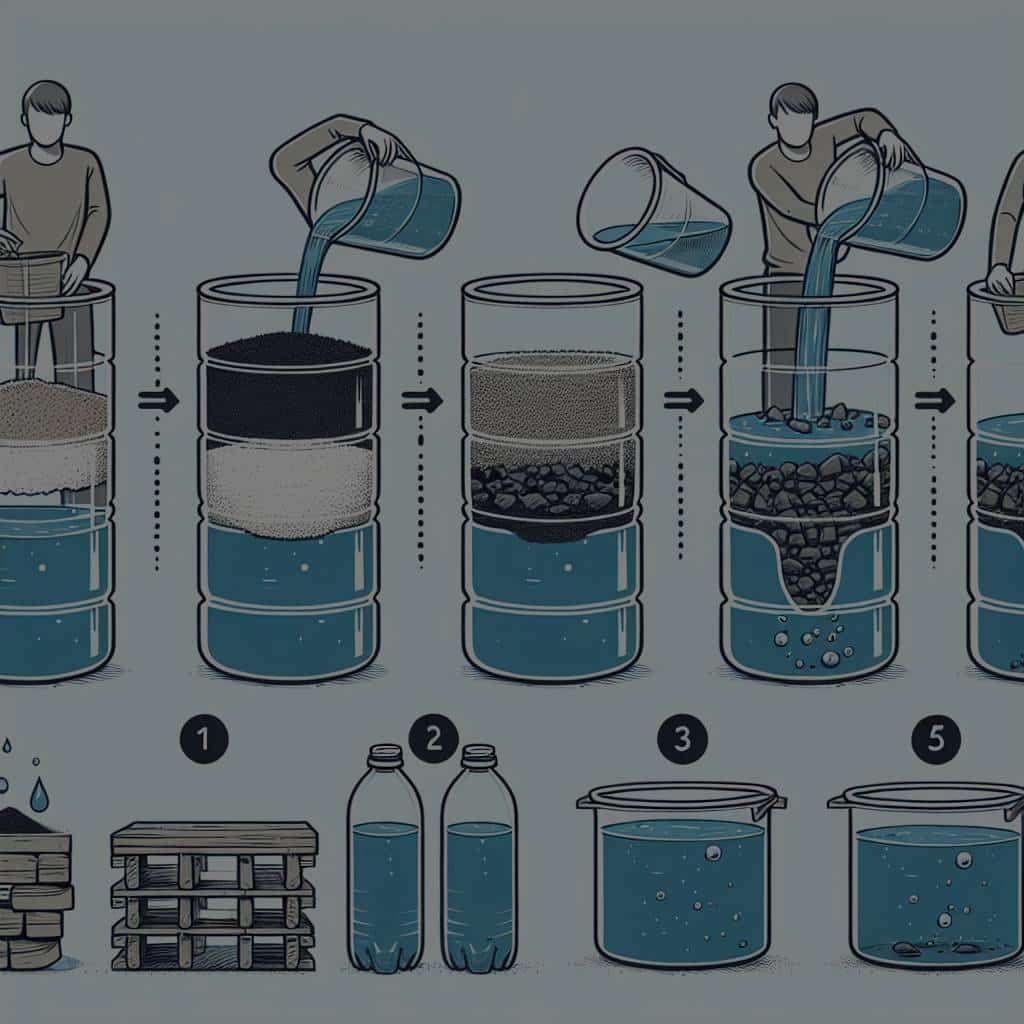How Can You Make a DIY Water Filtration System Using Natural Materials?

Knowing how to purify water is a crucial survival skill and an excellent project for those who enjoy DIY tasks. In this article, you will learn how to create your very own water filtration system using natural materials like sand, gravel, and activated charcoal. This simple, effective method will help you filter out harmful contaminants and produce clean, safe drinking water. The process may seem complicated, but we’ve broken it down into easy-to-follow steps that anyone can do.
Gather Your Materials
Before setting out on this exciting DIY project, it’s important to gather everything you will need. This includes a water bottle, sand, gravel, activated charcoal, a piece of cloth or coffee filter, and a rubber band or string.
In the same genre : What Are the Best Tips for Keeping a Home Gym Sanitized and Organized?
The water bottle will serve as the main body of the filtration system. activated charcoal is an essential component for this DIY filter. It’s a form of carbon processed to have small, low-volume pores that increase the surface area available for adsorption or chemical reactions. Its main function is to remove chlorine, volatile organic compounds, and other contaminants that affect water taste and odor.
Sand and gravel act as physical filters, trapping larger debris. The cloth or coffee filter secures the layers of sand, gravel, and charcoal in place while allowing the water to seep through.
Also to see : How to Create a Personalized Home Entryway That’s Functional and Welcoming?
Preparing Your Water Bottle
The first step in creating your DIY water filter is preparing your water bottle. You will need to cut the bottom off the bottle, turning it into a funnel shape. This will be the top of your filtration system where you pour the water into.
Ensure that the bottle is cleaned properly before you begin. Any contaminants present in the bottle could end up in your filtered water. In addition, make certain that the bottle is large enough to hold the materials and the water you wish to filter.
Creating the Charcoal Layer
The next step involves creating the charcoal layer within your homemade water filter. Crush the activated charcoal into small pieces and add them to the bottle. The charcoal should fill about a third of the bottle’s height.
The charcoal layer plays an important role in your filtration system. It absorbs several different chemicals, including some harmful ones, due to its large surface area. This process is known as adsorption.
Adding a Layer of Sand
After the charcoal layer, it’s time to add a layer of sand. The sand will form a fine-grain filter on top of the charcoal, trapping smaller particles that the charcoal cannot catch.
You should use clean, fine sand for this layer. You can either purchase it from a store or collect it from a natural source. If you decide to collect it yourself, ensure it is thoroughly cleaned to remove any potential contaminants.
Incorporating a Gravel Layer
The final layer in your DIY water filtration system is made of gravel. This layer will prevent larger particles and debris from entering the charcoal and sand layers.
Just like the sand, the gravel should be clean before you add it to the bottle. It’s important to use larger pieces of gravel to create a significantly different texture from the sand and charcoal layers. This difference in texture is what helps to filter out different sizes of particles from the water.
Finalizing Your Filter
With your layers in place, cover the top of the bottle with a piece of cloth or a coffee filter. Secure it with a rubber band or string. This piece acts as an extra barrier, preventing any sand or charcoal from escaping when you pour water into the filter.
Now your DIY water filtration system is ready. Pour water into the top and let it filter down through the various layers. The clean water then exits through the bottle’s mouth, leaving most of the contaminants behind in the different layers.
Remember, while this DIY water filtration system is great for filtering out debris, chemicals, and some bacteria, it doesn’t guarantee 100% safe drinking water. You may need to boil the water after filtration or use water purification tablets to ensure it’s safe for drinking.
Conclusion
Creating your own water filtration system using natural materials is not only an interesting DIY project, but also a useful skill to have. Activated charcoal, sand, and gravel can be effective in removing contaminants from water. However, always remember to ensure the water is safe for drinking after filtration, especially if you’re collecting it from an uncertain source.
Maintaining and Improving Your Filtration System
After completing your water filtration system, maintenance is key to ensuring it continues to function optimally. Regularly check your DIY water filter to ascertain the condition of the layers. The charcoal, sand, and gravel will gradually become saturated with contaminants and lose their effectiveness.
To start, observe the color and quality of the filtered water. If it appears cloudy or contains particles, this could be a sign that particles are bypassing the sand and gravel layers, or the activated charcoal is saturated. At this point, you should consider renewing the layers. To do this, simply remove the old materials and replace them with fresh ones.
In addition, you can also make improvements to your filtration system. Incorporating additional layers can increase the filter’s effectiveness. For example, a layer of small pebbles between the sand and gravel can help filter out medium-sized particles.
Another possible enhancement is the use of a pre-filter. A pre-filter can be made using a cloth or coffee filter to remove large debris before it reaches the gravel layer. This extra step can prolong the life of your filter by preventing large particles from clogging the layers prematurely.
Remember that the homemade water filtration system is designed to improve your water quality, but it doesn’t remove all contaminants. Some microscopic organisms and heavy metals can still pass through. For complete assurance of drinking water safety, consider boiling the water or using water purification tablets after filtration.
Conclusion
Building your own water filtration system using natural materials is a useful and practical skill. Not only does it provide a hands-on DIY project, but it also allows you to dramatically improve the quality of the water you consume.
In constructing this system, activated charcoal, sand, and gravel play integral roles by trapping and absorbing harmful contaminants. You can enhance your filtration system’s effectiveness by adding more layers and using a pre-filter.
However, it’s crucial to remember that while this homemade water filter can remove various contaminants, it does not guarantee completely safe drinking water. For absolute certainty, combine this filtration method with boiling or additional purification steps.
Ultimately, creating a DIY water filtration system is a step towards ensuring access to cleaner, safer water. It demonstrates how everyday materials can be utilized innovatively to improve water quality, contributing to better health and survival in emergency situations.
